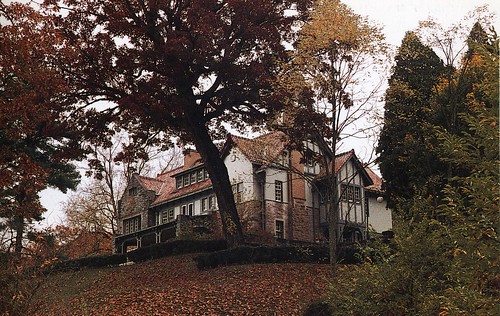The mansions were built between 1880 and 1910.
These lavish homes featured Italian marble, stained glass, European-made bricks, the first copper roof in America, ballrooms with red oak paneling, even indoor swimming pools…
Some of the wealthy would be billionaires today.
This isn’t New York City of 120 years ago. It’s not Newport, Rhode Island either, with its super-rich residents like the Vanderbilts and the Wetmores… 
This town is called Bramwell, named after J.H. Bramwell, a New York civil engineer who moved there in 1883 and became the first postmaster.
Bramwell is a West Virginia town.
It sits along the West Virginia-Virginia-Kentucky border, just a few miles from Bluefield, Virginia. It’s a stone’s throw from Hatfield-McCoy territory.
It’s also coal country.
Around the turn of the century, Bramwell had 4,000 residents and between 14 and 19 millionaires.By that time, J.H. Bramwell had already taken his fortune and moved to Switzerland.
But there were plenty of people profiting from the boom of the Pocahontas coal fields…
Isaac Mann was the president of Pocahontas Fuel Company for 35 years. He also owned a chain of nine banks and invested heavily in Chicago real estate. The Great Depression wiped out his $100 million fortune.
The Pocahontas coal fields opened in 1883. At their height, 100,000 miners worked these fields. Fourteen trains stopped in Bramwell every day. The streets were paved with bricks and the local pharmacy was the third store in the entire United States to stock Chanel No. 5.
Bramwell sits in Mercer County, West Virginia. Along with neighboring McDowell County, it mined more coal than other region of the United States as recently as 1960.
But by that time, the boom that made both of these counties among the wealthiest in America had long since past.
Both counties now are among America’s poorest…
McDowell County’s population has shrunk from 100,000 in 1960 to less than 22,000. As much as 46% of the population lives below the poverty line. The life expectancy is under 65 for men.
Today, you could buy this 9-bedroom, 4-bath, 7,000 square foot Bramwell Victorian for just $260,000:

Boom and Bust
There’s been no shortage of boom-bust cycles in America’s history.
There was the 1848 Gold Rush in California. Some people got rich, mainly selling picks and shovels to the waves of fortune seekers. Most did not.
Between 1865 and 1900, there was the railroad boom. Some made obscene amounts of wealth. However, building a railroad was very expensive. Companies that took on a lot of debt often failed. By 1893, the industry was dominated by just a few big companies.
Of course you know about the boom that ran from post World War I until the stock market crashed in 1929…
The United States has gone through a few oil booms as well. From 1859 and into the 1870s, Pennsylvania experienced an oil boom when Edwin Drake discover oil in Titusville. The town’s population jumped from 250 to 10,000 in just five years. Oil became America’s third largest export, at $30 million, in 1869.
In 1882, Rockefeller’s Standard Oil consolidated the Pennsylvania oil industry, effectively ending the boom.
An oil boom started in Texas when Anthony Lucas hit a gusher at Spindletop Hill in 1901. That same year, an estimated $235 million ($6.5 billion today) was spent speculating for oil in the Lone Star State.
The Texas oil boom continued with the discovery of the East Texas Oil Field in 1930, which would go on to pump 5.2 billion barrels of oil.
How to Play This Oil Boom
You’re no doubt aware of the current oil boom in the United States.
New fields like North Dakota’s Bakken and mature fields like Texas’ Permian Basin have boosted U.S. oil production to more than seven million barrels of oil a day.
In five years, U.S. oil production is expected to grow another 3.9 million barrels a day, to 11 million barrels a day.
There’s no doubt about it: There’s still a lot of money to be made from this oil boom.
Even better, you can now own oil assets that pay as much as 15% in completely tax-free income a year.
That’s a pretty good deal.
And it gets better: The tax-free payments rise as oil prices rise.
Over the last ten years, this investment could have turned a $10,000 stake into over $220,000 — plus generate over $18,000 in annual tax-free income.
It’s one of the best ways to profit from this oil boom — and it will keep paying you, even when the boom is done.
You can learn more about it here.
Until next time,
Until next time,

Briton Ryle
 The Wealth Advisory on Youtube
The Wealth Advisory on Youtube
 The Wealth Advisory on Facebook
The Wealth Advisory on Facebook
A 21-year veteran of the newsletter business, Briton Ryle is the editor of The Wealth Advisory income stock newsletter, with a focus on top-quality dividend growth stocks and REITs. Briton also manages the Real Income Trader advisory service, where his readers take regular cash payouts using a low-risk covered call option strategy. He is also the managing editor of the Wealth Daily e-letter. To learn more about Briton, click here.
 @BritonRyle on Twitter
@BritonRyle on Twitter